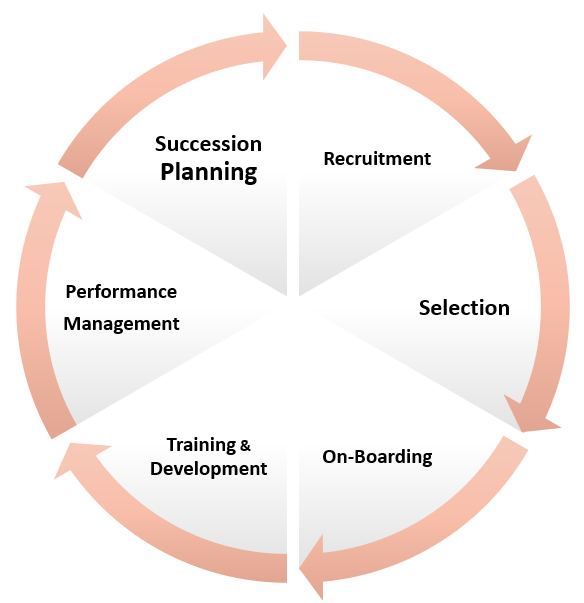Approaches to Talent Management
With any talent management approach, it is critical to be aligned with the broader organisational strategy. The environment surrounding the organisation is also taken into account when assessing the organisational strategy. Prior to developing the workforce plan, an evaluation of previous initiatives, an assessment of the workforce profile and talent performance and the behaviours to date, are carried out.
A workforce plan is then developed based on the current workforce situation and the future desired state. The workforce plan ensures that the right people, at the right time and with the right skills are employed and working towards the strategy. In other words, the workforce plan translates business strategy into organisational talent needs. Some of the areas, which are assessed in order to develop a workforce plan include:
- Developing Job Descriptions
For each job opportunity that you post for your company, whether it be internally posted or external, the descriptions that you choose are very important. Making sure to be as clear about what duties go into the performance of a job will ensure that the people who apply know exactly what is expected of them. You won’t have a high turnover rate because people were misled regarding what was going to be part of their job. Also, make sure that you list all of the necessary requirements for applying. This will help minimize the number of applications you have to discard because people who were not qualified applied anyway.
- Provide Development Opportunities
For existing employees, make sure to offer ongoing opportunities for people to develop in their profession. This can be something as simple as a two-day training class on something new that would aid in everyday duties, or it can be management training programs that allow entry level professionals to gain valuable knowledge, experience, and opportunities.
- Performance Assessments
A great way for employees to find out how they are doing and how they can improve is to do regular assessments. These can be done quarterly or twice per year in order to be effective. These assessments are usually done by management and give a brief overview of what was done by an employee, how their performance was, and how they can improve moving forward. This eliminates any surprises come bonus time or time for raises and talent on staff is always working towards new goals.
- Selection Process
Sometimes a candidate will stand out as being the right person for the job, however, there might be a big pool of people to choose from. A tried and true selection process will make your decisions easier and faster. You will want to make sure requirements are met, references check out, a resume is impressive and so on.
- Effective Compensation
In order to hire good talent, your compensation rates need to be impressive. They don’t have to be thousands higher than your competition, but there should be a distinct reputation present for being a good company with good compensation packages. Good health care benefits and additional perks always help to obtain talent and keep them on board. For example, something as simple as having on site, free parking can sway a person’s decision if they would otherwise have to pay hundreds of dollars each month to park somewhere else in the area at another company. Ongoing raises and bonuses are a great incentive and a reward for a job well done.
Approach A (Indoctrinate, Assimilate & Obligate)
- Focused on creating and grooming loyal disciples based upon the desired norms of corporate etiquette
- Inculcates shared values as a robust and binding foundation for a cohesive corporate culture that borders on fanaticism
- Encourages adherence to well-established and standardised work practices designed around functional optimisation and harmonisation
- Prefers corporate hierarchy for incentivising improvement initiatives
- Designs compensation packages as ‘golden handcuffs’ for maximising talent retention, especially, those who are considered ‘flight risks’ due to their particular skill sets and perceived lack of capable replacements
- Talent treated as an asset prone to depreciation.
- Training, learning and development is discretionary and generally based upon supervisory assessment/prerogative in accordance with the functional requirements.
Approach B (Accommodate, Motivate & Facilitate)
- Geared towards creating an empowering work environment that galvanises the utilisation of a wide bandwidth of apparent/hidden talents
- Uses shared values as guiding principles for self-discovery of work excellence and strengthening of organisational integration
- Encourages progressive experiments and ‘timely’ improves work practices for enhancing well-being, mindfulness and productivity of a multi-generational workforce
- Prefers thought hierarchy for incentivising innovation initiatives
- Designs compensation packages to enhance the employee experience during employment association for creating ‘alumni ambassadors’ as an astute employer branding measure to attract future talent
- Talent treated as an investment prone to rich dividends
- Training, learning and development is mandatory to ensure congruence between individual ambitions and corporate imperatives
- An astute talent management professional can effectively customise the most appropriate approach for optimising the benefits accrued from the available human capital by adhering to the following principle in congruence with the unique dynamics of an organisation.
